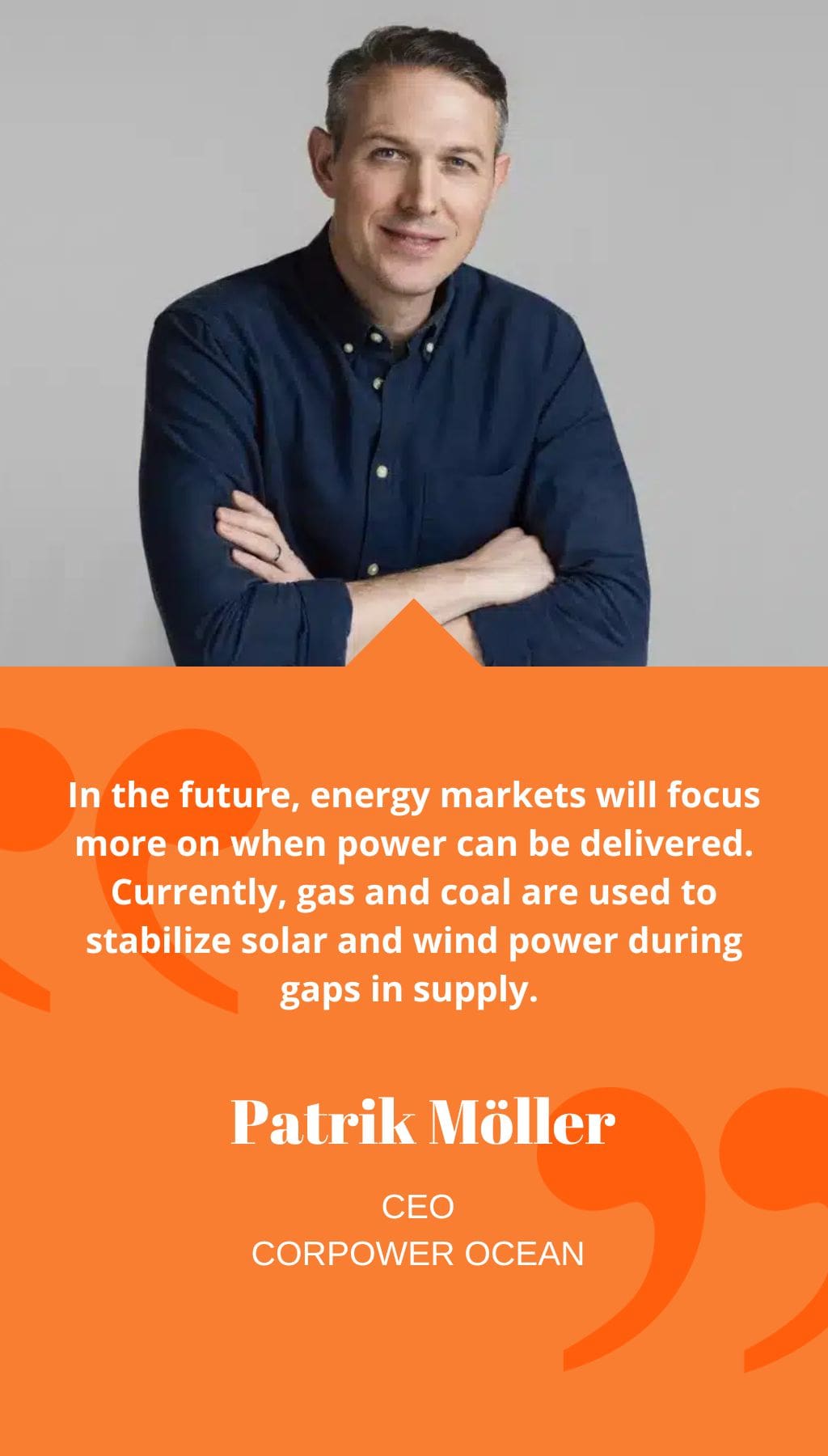
- Sweden | 2 October 2021

Can you explain the heart-based design of CorPower’s wave energy converter?
CorPower’s wave energy converter design draws inspiration from the pumping principles of the human heart. The technology was developed by our co-founder and inventor, Stig Lundbäck, who had extensive experience building mechanical hearts. The human heart pumps blood using a combination of muscle power and hydraulically stored energy. Similarly, CorPower’s wave energy converter utilizes an overpressure mechanism to push the buoy down to the midpoint at the flotation level. Wave swells then lift the buoy upwards, while the stored pressure provides the return force to drive the buoy downwards. This design enables the converter to generate energy in both directions, resulting in equal energy production.
Has the device undergone significant evolution in the past decade?
Yes, over the past ten years, we have made substantial advancements in the technology and successfully industrialized it. We collaborated with new inventors, including our lead scientist Dr. Jörgen Hals Todalshaug from NTNU in Norway, who specialized in wave energy control and hydrodynamics during his PhD. In 2014, Dr. Todalshaug invented the WaveSpring technology, which serves as our control mechanism and allows us to extract significantly more energy. We have built upon Lundbäck’s initial ideas and continuously incorporated new inventions into our technology over time.
How does CorPower achieve high levels of efficiency, and how does your technology compare to other products in the market?
CorPower has overcome two significant challenges that have hindered the progress of wave energy. Firstly, we have designed our device to withstand the toughest storms, providing protection during extreme weather conditions. When not actively controlled, the device lies still and allows waves to pass by. Secondly, our phase control technology amplifies motion and power capture in regular waves, ensuring efficient energy production under normal sea conditions. The combination of storm protection and efficient energy capture enables us to deliver five times more energy per unit of equipment compared to existing solutions. CorPower’s technology achieves a similar structural efficiency as modern wind turbines.
What are the preferred financing methods for wave energy projects, and do you anticipate the market to become self-regulated in the future?
Developing technologies like ours to an industrial-ready stage requires funding. In the early stages, we relied on public grants for research, and once we had proof of concept, we explored venture capital (VC) and private investment markets. To date, CorPower has secured approximately 65 million euros in funding. We aim to close a 50 million euro funding round by the end of the year to achieve a bankable product and begin shipping to customers by 2025. We are involving both industrial strategic investors and VCs in this equity raise.
We anticipate the first commercial farms to be operational in 2026, such as the Saoirse project by Simply Blue Energy off the west coast of Ireland. There is also interest from oil and gas installations looking to reduce CO2 emissions. This market is more tolerant of higher costs during the early stages. Additionally, we collaborate with utility companies aiming to power national grids, and public support is crucial to make early commercial farms investable. To reach a price point of approximately 65-70 euros per megawatt hour and achieve competitiveness with wind and solar in most markets, we estimate the need for approximately 600 megawatts of cumulative installations in the market.
In the future, energy markets will focus more on when power can be delivered. Currently, gas and coal are used to stabilize solar and wind power during gaps in supply. We need additional clean solutions to transition to 100% renewables. Wave energy can contribute to the clean energy mix by providing stability and balancing supply and demand at all times, thereby accelerating the transition to 24/7 carbon-free electricity.
Can you provide further details on what a wave energy project like Saoirse would entail?
We deliver our technology in the form of CorPack clusters, which consist of multiple units arranged side-by-side. Each CorPack cluster includes a wave energy converter, mooring system, anchors, and an electrical collection system. Typically, we offer these clusters in sizes of 10 to 20 megawatts, making them comparable to offshore wind turbines in terms of unit size. Developers can choose to build standalone wave farms or hybrid wind-wave farms where wave energy clusters are placed alongside wind turbines or in between them. Our modular approach enables scalable wave energy deployment, with many small devices that allow for economies of scale and volume production. Since each device is relatively small, local manufacturing becomes feasible. The high-density clustering of small identical machines ensures highly efficient use of ocean space, up to 15 MW per square kilometer.
Why is the ocean a promising source of energy, and what is your final message on this matter?
The biggest challenge in transitioning to 100% renewable energy is achieving balance and providing clean electricity throughout the year. This is where ocean energy can play a vital role. Wave energy, in particular, has the potential to bring stability to the clean energy mix and enable high penetration of renewables while balancing supply and demand continuously. This is crucial to accelerate the transition to 24/7 carbon-free electricity. The ocean provides a vast source of energy that can contribute significantly to our renewable energy goals.














